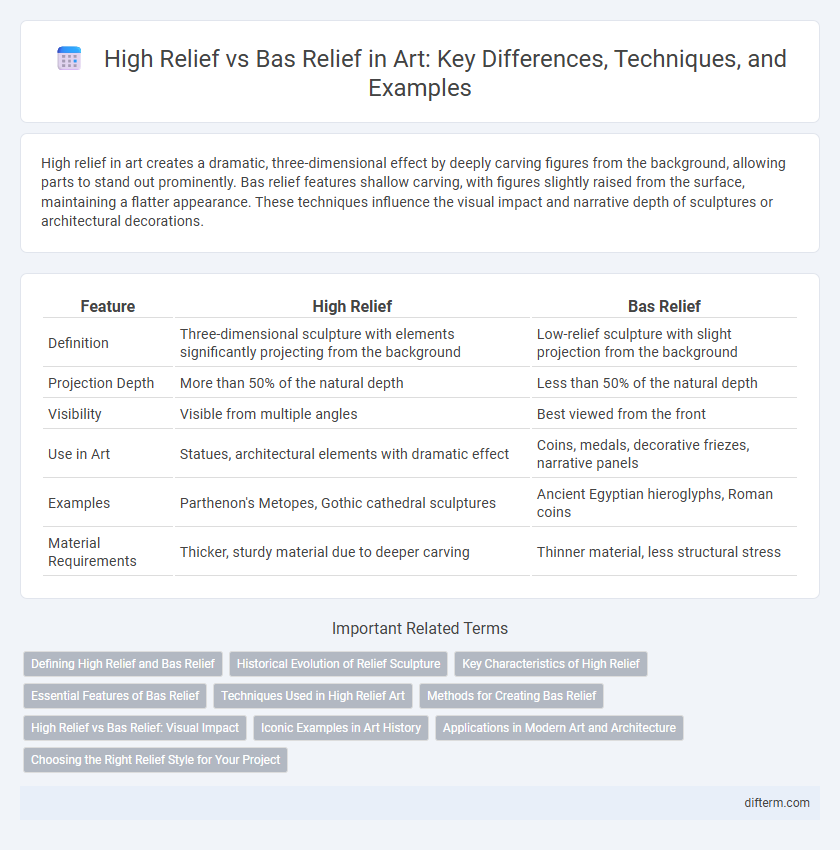High relief in art creates a dramatic, three-dimensional effect by deeply carving figures from the background, allowing parts to stand out prominently. Bas relief features shallow carving, with figures slightly raised from the surface, maintaining a flatter appearance. These techniques influence the visual impact and narrative depth of sculptures or architectural decorations.
Table of Comparison
| Feature | High Relief | Bas Relief |
|---|---|---|
| Definition | Three-dimensional sculpture with elements significantly projecting from the background | Low-relief sculpture with slight projection from the background |
| Projection Depth | More than 50% of the natural depth | Less than 50% of the natural depth |
| Visibility | Visible from multiple angles | Best viewed from the front |
| Use in Art | Statues, architectural elements with dramatic effect | Coins, medals, decorative friezes, narrative panels |
| Examples | Parthenon's Metopes, Gothic cathedral sculptures | Ancient Egyptian hieroglyphs, Roman coins |
| Material Requirements | Thicker, sturdy material due to deeper carving | Thinner material, less structural stress |
Defining High Relief and Bas Relief
High relief, or haut-relief, features sculpted elements that project significantly from the background, often extending beyond half their depth, creating a pronounced three-dimensional effect. Bas relief, or low relief, presents shallow depth where figures are only slightly raised from the background, maintaining a flatter appearance while still conveying detail and form. Both techniques are essential in adding texture and dimensionality to surfaces in architectural and artistic works.
Historical Evolution of Relief Sculpture
High relief and bas relief represent two distinct methods of sculptural carving that evolved significantly throughout history, with bas relief emerging prominently in ancient Egyptian and Mesopotamian art to depict narratives on temple walls and monuments. High relief gained prominence during the Renaissance, allowing artists to create more dramatic depth and dynamic figures that almost detach from their backgrounds, enhancing visual storytelling. Both techniques reflect technological advancements and shifting artistic priorities, with high relief emphasizing three-dimensionality and realism, while bas relief maintained a flat, narrative-driven format suited for architectural integration.
Key Characteristics of High Relief
High relief sculpture features deeply carved forms that project prominently from the background, often by more than half their depth, creating dramatic shadows and a strong sense of three-dimensionality. Unlike bas relief, which has shallow depth and subtle contours, high relief allows for undercutting and more dynamic representations of figures and details. This technique is commonly used in architectural decoration and monumental art to emphasize volume and realism.
Essential Features of Bas Relief
Bas relief, also known as low relief, features sculpted elements that project slightly from the background, creating a subtle depth while maintaining a flat overall surface. This technique allows intricate details to be visible without extensive shadows, making it ideal for architectural decorations and coins. Unlike high relief, bas relief emphasizes shallow depth and fine linear details, enhancing storytelling through minimal protrusion.
Techniques Used in High Relief Art
High relief art involves sculptural techniques where forms significantly project from the background, often extending more than half their depth, creating dramatic shadows and a three-dimensional appearance. Artists use deep carving and undercutting to enhance depth, allowing figures to appear almost fully detached from the background plane. This technique contrasts with bas relief, where the forms remain shallowly carved and closely attached to the surface, emphasizing subtle outlines and surface textures.
Methods for Creating Bas Relief
Bas relief is created by carving or etching shallow designs into a flat surface, often using tools like chisels, rasps, and fine blades to achieve detailed textures and subtle depth variations. Artists typically remove background material around the raised figures to enhance the illusion of depth while keeping the projection minimal compared to high relief. Techniques such as modeling clay or plaster before casting can also be employed to refine bas relief details and enhance the three-dimensional effect on surfaces like stone, metal, or wood.
High Relief vs Bas Relief: Visual Impact
High relief sculptures project dramatically from their backgrounds, creating deep shadows and a strong sense of three-dimensionality that enhances their visual impact. In contrast, bas reliefs offer a subtler effect by maintaining shallow depth, allowing intricate details to be visible while preserving a closer connection to the surface. The choice between high relief and bas relief influences how viewers perceive texture, depth, and narrative emphasis in artworks.
Iconic Examples in Art History
High relief sculpture, exemplified by the intricate Parthenon frieze in Athens, features figures that project significantly from the background, creating dramatic shadows and a sense of depth. Bas relief, seen prominently in the Low Relief panels of the Egyptian pyramids, displays shallow, subtle carving that remains close to the surface, emphasizing linear detail over depth. These distinct techniques have shaped the visual storytelling in art history by balancing dimensionality and narrative clarity.
Applications in Modern Art and Architecture
High relief in modern art enhances sculptural depth and dramatic shadows, making it ideal for dynamic architectural facades and public monuments that demand strong visual impact. Bas relief is extensively used in contemporary installations, decorative panels, and interior walls, providing subtle texture while maintaining structural flatness. Both techniques enable artists and architects to explore spatial narratives and surface articulation, enriching urban environments and cultural landmarks.
Choosing the Right Relief Style for Your Project
High relief offers dramatic depth and shadow, ideal for projects requiring strong visual impact and detailed three-dimensionality, while bas relief provides subtle contours suitable for intricate storytelling on limited surfaces. Selecting the right relief style depends on the desired interaction with light and viewer perspective, as high relief captures pronounced depth and movement, whereas bas relief emphasizes fine detail and flatness. Consider the project's scale, material, and viewing distance to ensure the relief technique complements the artistic vision and functional requirements.
High relief vs Bas relief Infographic

 difterm.com
difterm.com